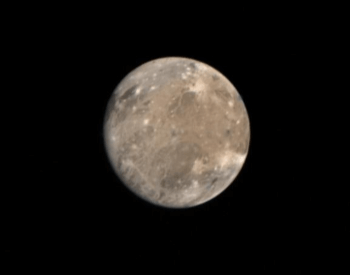
- Moon Name: Ganymede
- Formed: Around 4.5 billion years ago
- Discovered: January 7th 1610 by Galileo Galilei
- Distance from Jupiter: Between 664,370 miles (perigee) and 665,861 miles (apogee)
- Distance from the Sun: Around 484,000,000 miles
- Time to Orbit Around Jupiter: About 7 Earth days
- Total Surface Area: 86,999,665 square miles
14 Ganymede Facts for Kids
- Ganymede formed around 4.5 billion years ago.
- Ganymede was discovered by Galileo Galilei on January 7th, 1610.
- Ganymede is one of Jupiter’s seventy-nine known moons.
- Ganymede has a radius of about 1,636 miles.
- The closest Ganymede gets to Jupiter is 664,370 miles (perigee).
- The farthest Ganymede gets from Jupiter is 665,861 miles (apogee).
- It takes Ganymede about seven Earth days to orbit the planet Jupiter.
- Ganymede is the largest moon in our Solar System.
- Ganymede is ninth largest object in our Solar System.
- Ganymede is the largest object in our Solar System that doesn’t have a substantial atmosphere.
- When the surface is exposed to the sunlight the temperature can get as high as -171 degrees Fahrenheit.
- When the surface isn’t exposed to sunlight, the temperature can get as low as -297 degrees Fahrenheit.
- Jupiter’s moon Ganymede is the only moon in our Solar System to have a magnetosphere.
- Since Ganymede has a magnetosphere, it’s most likely has a liquid, iron-nickel rich core.
Pictures of the moon Ganymede

A photo of Jupiter’s moon Ganymede, taken by Voyager 1 on 3/4/1979.Credit: NASA

A photo of Jupiter’s moon Ganymede, taken by the Galieo Spacecraft.Credit: NASA

A beautiful picture of Ganymede in orbit around the planet Jupiter.Credit: NASA
Additional Resources on Jupiter’s moon Ganymede
- Ganymede Moon – Wikipedia – Learn more about Europa on the Wikipedia Website.
- Ganymede – Lunar and Planetary Institute – Find out more amazing things about Ganymede on the Lunar and Planetary Institute website.
- In Depth | Ganymede – NASA Solar System Exploration – Discover more awesome facts about Ganymede on the NASA Solar System Exploration website.
- Ganymede: Facts About Jupiter’s Largest Moon – Dive deeper into Ganymede on the Space.com website.
